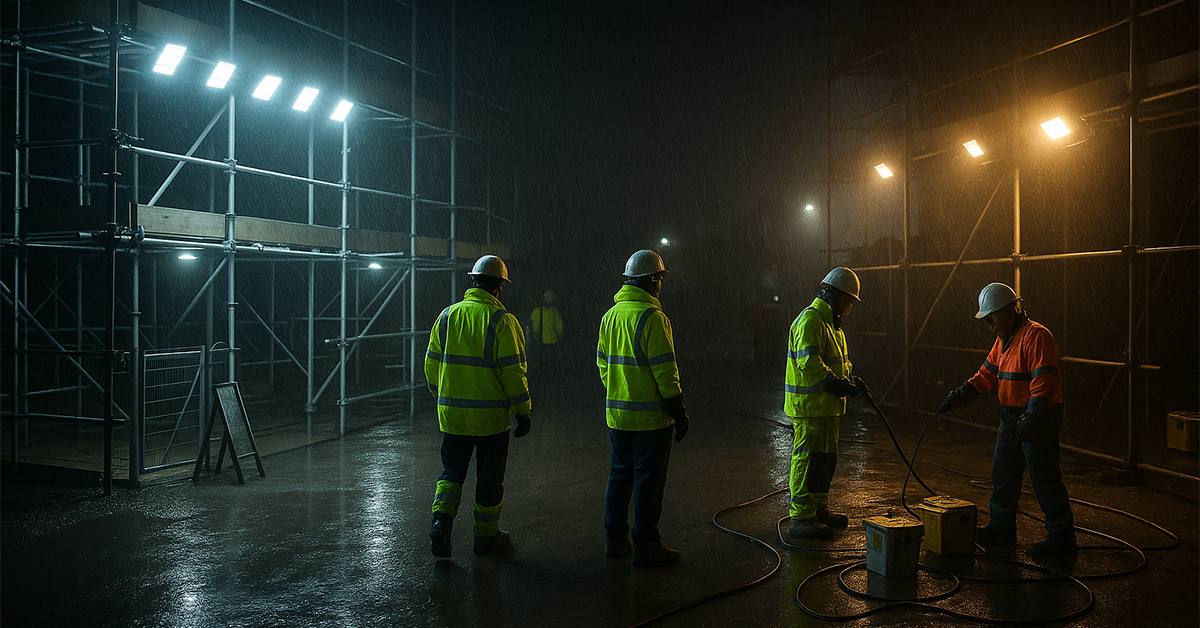LED vs Halogen: The Best 110V Site Lights for Energy Efficiency

A Late-Night Lesson in Site Lighting
It’s 2am on a rainy construction site in Manchester. The crew is working under pressure to meet a deadline, but suddenly half of the halogen floodlights go out. The foreman scrambles for replacements, but the spares are already gone. Work stalls, frustration builds, and precious hours are lost.
This scenario is all too familiar for site managers across the UK. Lighting isn’t just about visibility; it’s about safety, productivity, and efficiency. That’s why the debate between LED vs halogen 110V site lights has become so important. With tighter budgets, rising energy costs, and stricter safety regulations, choosing the right lighting solution can make or break a project’s success.
In this blog, we’ll break down the strengths and weaknesses of LED site lights and halogen site lights, helping you decide which option offers the best energy efficiency, cost savings, and durability for UK construction sites.
Why 110V Site Lights Are Standard in the UK
Before comparing LED and halogen, it’s important to understand why 110V site lights are the industry standard in the UK. Unlike 230V mains power, 110V significantly reduces the severity of electrical shocks, which is critical on wet, unpredictable construction sites.
The Health and Safety Executive (HSE) recommends using reduced low-voltage systems for portable tools and lighting, and many UK contractors now see 110V equipment as non-negotiable for compliance and safety. In short: 110V site lighting isn’t just a preference it’s about meeting safety standards while ensuring workers are protected.
Energy Efficiency: LEDs Lead the Way
When it comes to energy-efficient site lights, LEDs have changed the game.
- Halogen lamps typically deliver 15–25 lumens per watt, meaning they use more power to produce the same brightness.
- LED site lights, by contrast, deliver 80–100 lumens per watt or more. That’s a 70–80% reduction in energy use compared with halogen.
On a busy construction site running lights for 10+ hours a day, this difference translates into substantial savings on electricity bills. Not only do LEDs consume less power, but they also maintain consistent brightness without the warm-up time that halogens require.
Imagine powering ten halogen lamps at 500W each versus ten LEDs at 100W each. Over weeks of use, the energy savings are significant, and those savings directly improve the project’s bottom line.
Lifespan and Maintenance: Less Stress with LEDs
Halogen bulbs are notorious for their short lifespan. A typical halogen site light lasts around 2,000 hours, and the fragile filament often fails early due to vibration or accidental knocks on site.
By contrast, LED site lights last 25,000–50,000 hours. That means years of use before replacement, even under harsh conditions.
The practical impact?
- Fewer bulb changes in awkward, hard-to-reach positions.
- Less downtime for crews waiting for lights to be replaced.
- Lower ongoing maintenance costs.
A project manager in Birmingham recently shared that switching to LED cut their annual replacement budget by more than half savings that went straight back into project development.
Heat Output and Safety: Staying Cool Under Pressure
One of the biggest drawbacks of halogen lamps is the intense heat they generate. Anyone who’s worked under halogen floods knows they can burn to the touch and create fire hazards if placed near flammable materials.
LEDs, on the other hand, run much cooler. Their efficient energy conversion means less wasted heat, reducing both fire risks and discomfort for workers operating nearby. On sites where cables, timber, or other combustible materials are present, this cooler performance makes LEDs the safer option.
Cost-Effectiveness and Long-Term Savings
At first glance, halogen lamps appear cheaper; you can buy them at a fraction of the upfront cost of LEDs. But the story changes when you factor in electricity bills, replacement frequency, and downtime.
For example:
- Running a 500W halogen lamp for 10 hours consumes 5kWh of electricity.
- Running a 100W LED floodlight for the same period consumes just 1kWh.
Over a month, the halogen will rack up five times more energy costs. Add to that the cost of frequently replacing bulbs, and the LED’s higher initial investment quickly pays for itself.
Contractors who’ve made the switch often report breaking even on the initial cost within the first year with ongoing savings year after year.
Light Quality and Durability
On a construction site, brightness isn’t the only factor. Workers need consistent, clear light to ensure safety and precision.
- Halogen lights provide a warm glow with good colour rendering, but their performance dims quickly over time.
- LEDs deliver crisp, bright illumination with excellent colour rendering, making it easier to distinguish materials and read markings on site.
Durability is another key factor. LEDs are solid-state devices with no fragile filaments, making them far less susceptible to damage from vibration, knocks, or extreme weather. This ruggedness gives them the edge in demanding site environments
A Foreman’s Switch to LED
On a large housing project in Leeds, the site foreman noticed his team spending hours each week changing blown halogen bulbs. Frustration mounted as downtime added up, and energy bills spiralled.
After switching to LED 110V site lights, the difference was immediate. The new lights lasted the entire project without replacements, energy consumption dropped by nearly 70%, and productivity improved because crews could rely on consistent illumination.
This simple upgrade didn’t just improve efficiency it boosted morale and confidence across the workforce.
Practical Takeaway for Site Managers
If you’re still relying on halogen site lights, consider the long-term impact: higher energy bills, more downtime, and greater safety risks. Switching to LED 110V site lights isn’t just about technology, it’s about ensuring your workforce has the best environment to perform at their peak.
The numbers, the safety benefits, and the real-world stories all point in the same direction: LEDs are the future of UK construction lighting.
Conclusion: Lighting the Way with Connexion Electrical
When weighing LED vs halogen 110V site lights, the evidence is clear. LED site lights outperform halogen in every major category: energy efficiency, lifespan, safety, cost-effectiveness, and durability.
For contractors and site managers who want reliable, energy-efficient lighting solutions that meet UK safety standards, LEDs are the smarter investment. And when it comes to sourcing high-quality 110V site lights, look no further than Connexion Electrical. With trusted expertise and a wide range of options, Connexion Electrical can help you light your site safely, efficiently, and cost-effectively.


